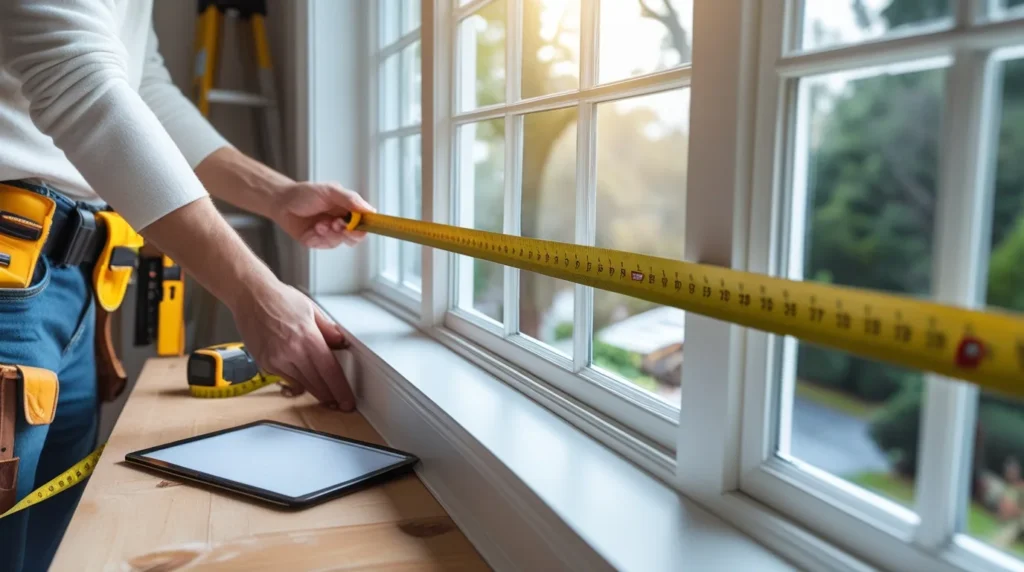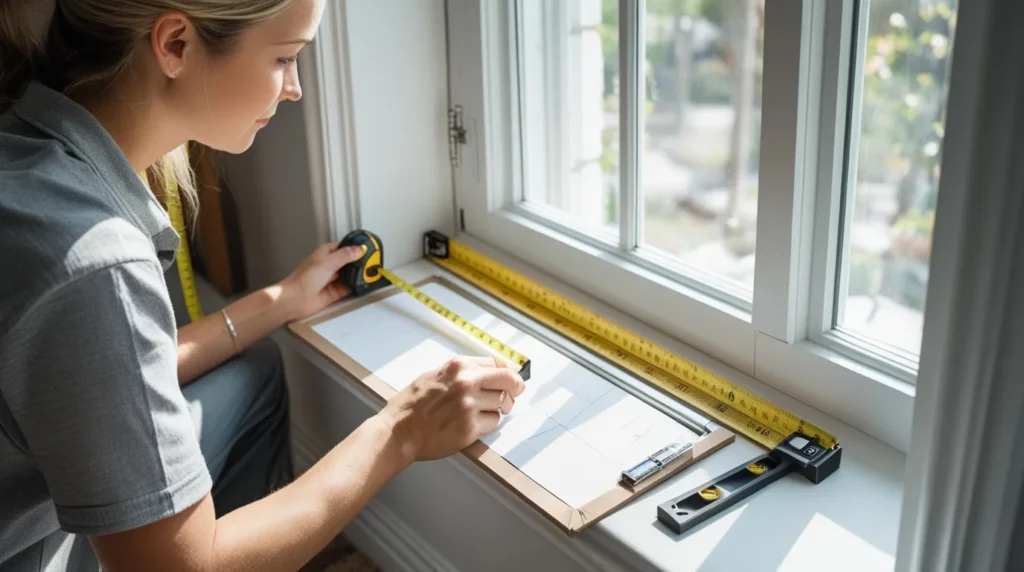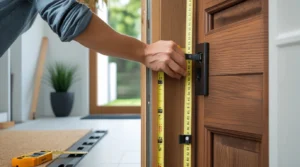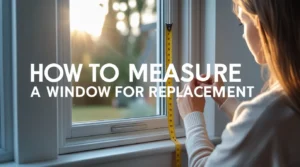When your window is broken, drafty, or just old, you might want to replace it. But before you go shopping, there’s one very important step: learning how to measure a window for replacement. If you don’t get the measurements right, the new window won’t fit. This can lead to air leaks, water damage, or wasted money.
Measuring your window correctly helps you get a window that fits perfectly. And no, you don’t need to be a builder or expert. With a little time, care, and the right steps, anyone can measure their own window—even if you’ve never done it before.
In this complete guide, we’ll walk you through the steps in a simple way. You’ll learn what tools to use, what mistakes to avoid, and how to check if your home needs custom windows.
Why Measuring a Window Correctly Matters Before a Replacement

You might wonder why getting window measurements right is such a big deal. The truth is, when a new window doesn’t fit, it causes many problems. A window that’s too large won’t go in at all. A window that’s too small leaves gaps, which can let in cold air, bugs, or even rain. These small openings can drive up your energy bill and damage your walls over time.
Getting the right size from the start helps the whole job go faster and smoother. You’ll save money and avoid delays. When the window fits just right, your home stays warm in the winter, cool in the summer, and protected from the outside weather. That’s why learning how to measure a window for replacement is one of the most important steps before starting your project.
What You Need to Know Before You Start Measuring Windows
Before you begin measuring, it’s good to understand a few things. First, figure out if you’re replacing just the glass or the entire window frame. This will help you know what kind of measurements you need. Some windows are standard sizes, but older homes might have custom window sizes. That means your measurements have to be exact.
You’ll also want to get your measuring tape, a pencil, and a piece of paper ready. A small ladder may help if the window is high up, and a flashlight is useful if the area around the window is dark. It’s best to measure during the day when there’s plenty of light. Take your time, and don’t rush. Careful measures now can save you lots of time and money later.
Understanding How Windows Are Measured: Width, Height, and Depth
Window sizes aren’t measured like curtains or furniture. You can’t just guess the outside size and go shopping. You must measure three things:
- Width: side to side
- Height: top to bottom
- Depth: how thick the window opening is
To get the width:
- Measure inside the frame at the top.
- Measure across the middle.
- Measure at the bottom.
Use the smallest number you get. That’s your correct width.
Now measure height:
- Left side from top to sill.
- Center from top to sill.
- Right side from top to sill.
Again, use the smallest number for your height.
Measuring the depth is simple:
- Open the window if you can.
- Use your tape to measure the frame from inside to outside.
- Don’t include trim or extra framing—just the window frame itself.
If the depth is less than 3¼ inches, you may need a special window called a “slim” or “shallow” replacement window.
A Step-by-Step Window Measurement Guide for Beginners
Here’s a friendly walk-through:
Step 1: Measure Width
- Place the tape measure inside the window frame.
- Start at one inside edge and go to the other.
- Do this at the top, middle, and bottom.
- Write down all three. Circle the smallest one.
Step 2: Measure Height
- Start from the top inside frame and go down to the sill (bottom).
- Do this on the left, center, and right sides.
- Again, record all three and circle the smallest.
Step 3: Measure Depth
- Open the window and measure from the inside edge to the outside edge of the frame.
- Don’t count any trim or stops.
Step 4: Check for Squareness
- Measure diagonally from top left to bottom right.
- Then measure from top right to bottom left.
- If both are nearly the same, your window opening is square.
- If not, the frame is out of shape, and you may need a custom fit.
Always write down your results clearly:
Example:
- Width: 35 ¼ inches
- Height: 58 ⅝ inches
- Depth: 3 ½ inches
How to Measure a Window for Replacement: A Step-by-Step Breakdown
You now know the basics, so let’s apply them to how to measure a window for replacement in real life.
Let’s say your kitchen window is old and foggy. You want to replace it with something more modern. Follow this checklist:
- Use a good quality tape measure.
- Don’t guess—measure every part.
- Use the smallest number when choosing window size.
- Write down width first, then height. Example: 36 x 60.
- Double-check your numbers.
Even if your home has different types of windows—casement, double-hung, or sliding—this guide works for all.
If you are using a window order form, they usually ask for width first and height second. So if your measurements are 36 inches wide and 60 inches tall, it would be written as 36 x 60.
This is also helpful if you’re working with a contractor. It shows that you understand the process and helps avoid miscommunication.
Inside or Outside? Where to Measure Your Window Correctly
Many people ask, “Should I measure from inside or outside?”
The answer: measure from the inside unless your installer tells you otherwise.
Why?
- It’s safer and easier.
- You’ll get more accurate frame measurements.
- You can measure depth easily from inside.
If you’re unsure, you can still check outside to compare, but always go with the smallest measurements.
Remember: We’re measuring the opening, not the whole wall or trim. Don’t include outside decorative trim or sills.
How to Measure a Window Size for Glass or Frame Replacement
Sometimes, you don’t need a full window replacement. Maybe only the glass is cracked.
If so, you just need to measure the glass part, not the whole window.
- Measure the visible part of the glass — width and height.
- Don’t include the frame.
- Be careful with sharp edges if the glass is broken.
- Note the thickness if you can. Some windows use double-pane glass, and some are single-pane.
If the whole frame is rotting or warped, it’s better to replace the full window. For this, go back to measuring the entire frame like we explained earlier.
How to Measure for a New Window in an Older Home
Older homes, especially those built decades ago, may have odd-sized windows. Homes in Aurora, CO, for example, may have wood-framed windows that have shifted over time.
What should you do?
- Check if the window is square by measuring the diagonal.
- Look for water damage or wood rot around the frame.
- Some windows may need to be custom made.
- Take extra measurements just to be sure.
If you’re not confident, it’s okay to call a pro. DnG General Services can help you with old window frames and suggest what type of replacement window fits best.
Also, in older homes, it’s common for one side of the frame to be slightly lower than the other. These small shifts mean you may need a bit of caulking or shimming during installation.
Common Mistakes to Avoid When Measuring a Window to Replace

Even smart homeowners make mistakes when measuring windows. Let’s help you avoid the most common ones:
- Measuring from the trim instead of the frame.
- Using outside measurements.
- Not checking if the frame is square.
- Only measuring one side or one spot.
- Rounding up your numbers (always use the exact measurement).
- Forgetting to label height and width.
A good rule is to measure twice (or even three times) before buying or ordering.
Local Tip: Measuring Replacement Windows in Aurora, CO Homes
In Aurora, CO, homes can be very different from one another. Some are newer houses with vinyl windows, while others are older homes with wood frames that may have shifted over time. This is important because wood can shrink or swell depending on the weather. Cold winters and hot summers in Aurora also put a lot of stress on windows.
When you measure a window in a home here, always check if the frame is still straight and square. That helps you know if you need a regular replacement or a custom-sized one. If your home has had a lot of snow or rain over the years, check for signs of damage around the window before taking your measurements. In some cases, the area may need repairs first.
If all this sounds tricky, it’s okay to ask for help. A local company like DnG General Services knows what to look for in Aurora homes. They can guide you through the process and make sure everything is measured just right the first time.
Trust DnG General Services for Accurate Window Replacement Support
Measuring windows may sound tricky at first, but with this guide, you now know how to measure properly. You’ve learned about width, height, depth, and how to avoid common mistakes.
But if you’re still unsure, don’t worry. DnG General Services is here to help. We’ve worked on homes all across Aurora, CO. Our team is experienced, friendly, and ready to make sure your new window fits just right.
We take our time to measure, plan, and install your new windows with care. Because when it comes to your home, we believe in doing it right the first time.
Need help measuring or replacing your windows? Contact DnG General Services today. Let us handle the details so you can enjoy a warmer, safer, and more beautiful home—stress-free.







